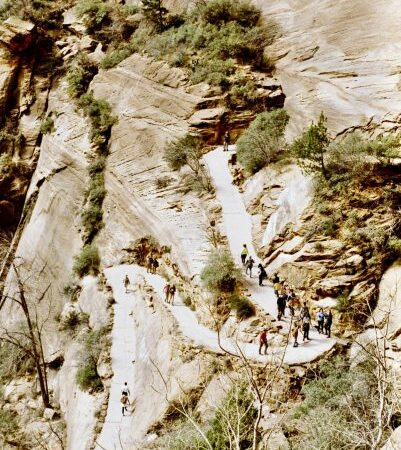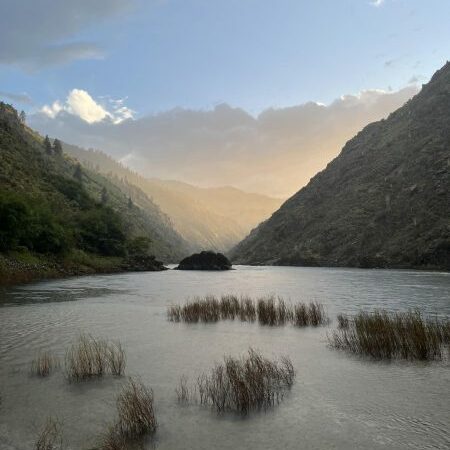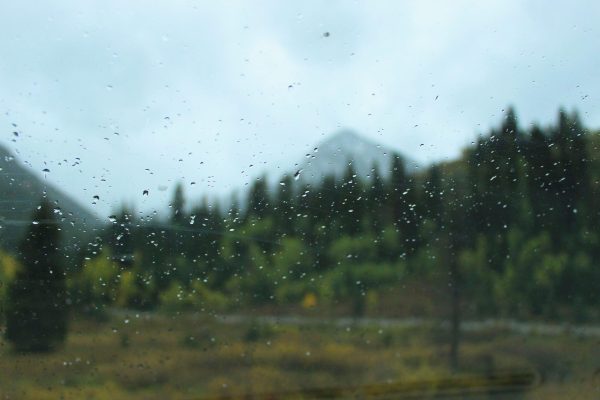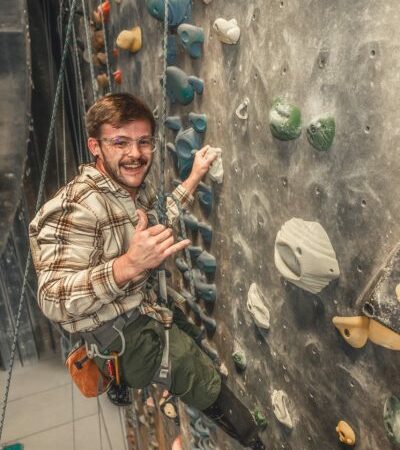Training to Ski Through an Injury
Sometimes something needs to go terribly wrong in order for one to understand what needs to be done right. Call it learning from a stupid mistake, or experimentation on oneself.
Either way, the story starts with me lying upside down on the icy run with one ski on, wondering if I’ll be able to stand up, or if this will be the time I finally need to be dragged down in a sled.
After the first moments following a crash, thoughts are not complicated. It is like stubbing a toe: a string of obscenities for the pain at the stupidity of my own actions and at the world in general. This time my knee felt like well pulled rubber bands, and it hurt a lot. I was freaking out quite a bit. As for what happened, I collided with something buried in the snow; my knee twisted hard to adjust for the immediate change in ski direction. After which I dove face first into the snow and my ski flew off into the air like a giant boomerang. Lying on the run, the thought that hit me after a few moments was at least I still could get up. Somehow, I didn’t need help from the ski patrol, and despite a lack of stability from my left leg I somehow managed to get up, find my ski and make a slow and painful descent back to the car.
Thinking about the incident and considering the kind of impact I took; I think the probability of me maiming myself was quite high. I could have very easily torn many of the ligaments within my knee quite badly, but I only really had more severe damage to my sartorius and part of my hamstrings. I was in rough shape and couldn’t stabilize a fully extended knee, but I wasn’t fully out for the count. That led me to a follow-up question, why hadn’t I been more seriously hurt earlier this season? What part of the training I have been doing over the past year or so is contributing to improved joint durability? Skiing is a very injury prone sport. So anything we can do to improve the odds and reduce the chance of injury to keep having fun is incredibly valuable.
Does a certain kind of training contribute to improved durability over others? If so, what methods of training can be used to reduce the chances of a severe injury, while simultaneously improving the ability to move more fluently and athletically on skis? Lastly, how can we make meaningful recovery from injuries? Hurting myself forced me to consider all this, and now writing in January, I am mostly able to ski to the best of my ability and have fun; confident that I can rely on my knee.
I think the concept of training for something in specific daunts many people. To dispel any misconceptions right off the bat, there is no easy way to force the body to adapt. If we want to force our bodies to improve, it’s going to take a lot of time, anywhere from months to years. Not to mention that all this time we must stay disciplined though a lot of hard, potentially painful activity. Ultimately that is what it will take for one to develop an intimate understanding of the kinds of stimulus that force the body to change. We can’t just go into a gym and throw weights around, there needs to be a method to the madness.
Skiing is a dynamic activity that requires many different kinds of motions depending on the discipline and conditions. It requires the ability to exert force explosively, maintain control throughout an entire range of motion, as well as having quick reaction speeds, high levels of stamina and cardiovascular endurance. What follows is what has been working for me, but it needs to be acknowledged that everyone has a slightly different physiology and different people can get better stimulus from different exercises. At the end of the day, it is up to the individual to figure out what works best for them.
I think a lot can be said with very little for training flexibility. It allows one the ability to extend a range of motion and improves the body’s ability to avoid injury. Flexibility is about preparation. We might never intend to move a certain way while skiing but crashing doesn’t necessarily care if we were intending to do something or not. All it takes is twisting something a bit farther than we are used to in an uncontrolled manner to hurt ourselves. Work on extending ranges of motion throughout the whole body gradually day after day; slowly pushing through a stretch as well as holding positions for a period of time. This is something that I had started doing years ago, but I was lacking some more significant flexibility in my hamstrings, so the jury is still out.
Being bendy is great, but it’s only one component of what we need to be durable. We need to do some strength training to be strong enough to fully control ourselves throughout an entire range of motion. There are many different kinds of strength training that could be done, and not all of it is going to be effective for the purposes of skiing. Since this is the most intensive part of training, it is important to pick an effective routine that will check all the required boxes for what we want to do. Ultimately, we want to be strong enough to aid us in our athletic abilities. One does not need to get massive.
It also goes without saying, proper form and control would help one avoid crashing to begin with. So to improve form, we need to train the specific motions that we use when skiing in the gym so we undergo the necessary neuromuscular adaptations to improve the body’s fluency in those motions.
To figure out what exercises to do I find it helps to look at proper neutral skiing form for inspiration: knees slightly bent with the hips stacked over the feet, back straight, and keeping the chest square to the fall line. We also have to remember that skiing involves unilateral production and absorption of force, especially when changing direction in a turn, slowing down in bumps or any sliding motions. Next, we need to identify the ranges of motion our body will move through and how that form will change through movement.
In my opinion, squats are without a doubt the #1 exercise to train when it comes to skiing. We can train for almost all scenarios by slightly altering the type of squat. While strictness of form, discipline of breath and keeping control throughout the entire range of motion can be super difficult, it is very important. The harder something is, the more stimulus we will generate, and therefore the more adaptation. In other words, no pain no gain.
I think using a leg press or hack squat machine is a great way to train skiing form because one can position the legs directly under the hips and squat with the knees moving in parallel, all while maintaining good back posture. Alternatively, cossack squats move through the frontal plane of motion, rather than the sagittal plane like a traditional squat. Doing these along with weighted lunges, one can train each leg at a time. There are a number of benefits in doing this, including training core stability, balance and controlling weight transfer using the adductor muscles. Finally, the traditional barbell squat is great to round everything out. Be strict with your form. No partial repetitions, drive your knees over your toes, lower your butt to the floor while inhaling and drive back up hard while exhaling. These kinds of squats are brutal, but they also ensure that you are very strong through the entire range of motion. They help your ability to drive your shins into your boots, as well as drilling the right breathing patterns for skiing moguls.
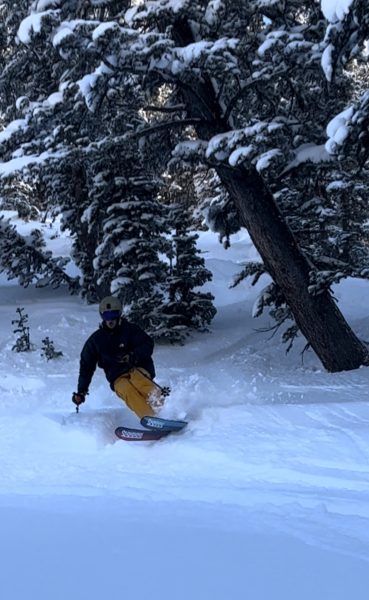
Control of the ski’s edges and upward pop are often best initiated by pressure from the balls of the feet. To train this, do weighted calf presses, and be sure to vary the angle of your feet to target different muscle fibers.
For twisting the hips around relative to the torso, we use our obliques, however, these have the dual function of stabilizing the core on the frontal plane, so we need to do a variety of exercises. We can train these with slow and controlled variations of wood chops, unilateral lifts, and Russian twists, either lying on the ground or hanging from a bar.
Powder and bump skiing requires an adjustment of form and engages more from our core and posterior chain because stability in deep powder demands that one sit more backseat to maintain nose lift and buoyancy. We can do low bar squats, which position the weight onto the back and therefore require more activation of the glutes and hamstrings when pressing. Similarly, we can do “Good Mornings”, which are a bit like a weighted toe touch. Leg raises, sissy squats and holding a V will train the ability of the abdominal wall to maintain stability and ensure form integrity when leaning back onto skis.
I would also highly recommend exercises that train the upper body; compound movements like pullups and different presses all engage the muscles of the core for stability.
For training reaction speeds, it is important to train for explosiveness with these exercises.
Explosiveness is not going to necessarily come from the kinds of exercises we do, but from the manner in which we perform them. When training legs for skiing, I don’t necessarily concern myself with the amount of weight lifted upwards, rather I focus on controlling the descent of the weight and then returning to my original position quickly through one strong focused movement. Doing this will recruit more of our fast twitch muscle fibers to be involved in the movement. This is because that is exactly what we do when we ski. We absorb the impact, and then reset as quickly as possible for the next bump, jump or turn, over and over. In all once you step into your bindings, the result of having to push weight around will be that you won’t notice you have skis on your feet.
Leading to the last point about training: endurance. Endurance and stamina come from doing low intensity, long duration workouts and cardio (sprinting is great!) We basically want to use muscles over and over; pushing through fatigue and exhaustion, while progressively making the exercise more challenging over time. The best way I have found to train this is to go and climb a mountain with a loaded backpack once or twice a week. This is nice, you can take your time, enjoy nature and have fun, but at the end of the day you are challenging yourself by doing something incredibly physically exhausting. And that’s exactly what you need to do.
Lastly, recovery. The right training diet and getting enough sleep is critical to seeing progress. Ensuring we get plenty of good sleep will help muscles rebuild after we destroy them. A well-balanced diet consisting of whole foods (no processed carbs) and higher volumes of protein (I would say about a fist sized portion for every meal) is crucial for consistent muscle recovery. Try to listen to your body. If you feel weak and tired, you need to make a change to resolve that issue, or else you are going to stagnate.
While we can’t make ourselves immune from an injury, we can develop a strong base that might be able to lessen the amount of time in recovery. Or at the very least make it suck less. Other muscles are more able to assist in the tasks of an affected area, but that doesn’t change the fact that an injury needs to heal. Unfortunately, I don’t think anything can be done apart from waiting. We need to take time to rest. However, I don’t think that should be an excuse to stop all physical activity. We should try to stay in shape so that we can pick up right where we left off.
Movement through the available range of motion is definitely a good idea. It can send blood to the affected region, and you won’t be as stiff while healing. That being said, we don’t want to train in any way that will continue to harm our injury. When it comes to weight training, avoid that muscle or lighten up on the weights for compound movements.
Instead, slowly start working on mobility and flexibility exercises only using bodyweight and work back up to weights. Healing is a process that is slow and delicate, and we need to remember that even after something feels strong, it likely is still slightly weaker than we expect, and we are likely more susceptible to hurting that area again when fatigued. By continuing to move, we can get a very good idea where we are in the healing process. If you can ski, go for it! But be wary of how you are feeling.
Fortunately, if one wants to learn more and start their own training, there is a wealth of information online. Everything from the ways to optimize training, diet, sleep, and exercise is available. Not all of it is legitimate, but there has been somewhat of a renaissance in treating sports medicine as a science, so there are plenty of reviewed papers and studies on the latest research, as well as a plethora of videos and guides on how to perform various exercises properly. It’s up to the individual to do the research, develop a plan and figure out what works for their individual needs and activities. Have fun and stay safe!
The post Training to Ski Through an Injury appeared first on Wasatch Magazine.
Source: https://wasatchmag.com/training-to-ski-through-an-injury/

